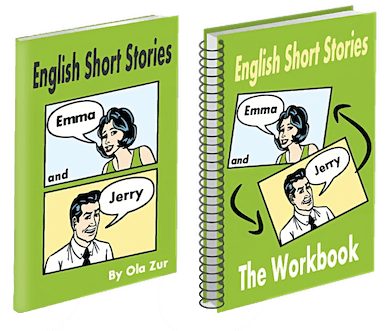Spelling Rules for Adding
"ed"
Introduction
Vowel = a sound we make when the breath flows out through the mouth freely, without being blocked. The English letters a, e, i, o, u are called vowels, because they represent such sounds.
Click Here for Step-by-Step Rules, Stories and Exercises to Practice All English Tenses
Consonant = a sound we make that is not a vowel. The breath is somehow blocked on its way out of the mouth. For example, the sound b is made when breath flow is stopped with the lips. All the English letters which are not vowels are called consonants. These are: b, c, d, f, g, h, j, k, l, m, n, p, q, r, s, t, v, w, x, y, z.
Download a free worksheet + answer key.
Some verbs change their spelling when "ed" is added to them.
Verbs ending
with
"consonant-vowel-consonant"
When a verb ends with a consonant-vowel-consonant
and we put STRESS on this sound in speech, we double the last consonant.
Then we add ed.In the following examples the consonant is in blue, the vowel is in green, and ed is in red. The STRESS is underlined.
| stop | => | stopp + ed | => | stopped |
| plan | => | plann + ed | => | planned |
But if we don't put STRESS on this sound in speech, then we simply add ed.
| open | => | open + ed | => | opened |
| visit | => | visit + ed | => | visited |
| listen | => | listen + ed | => | listened |
| happen | => | happen + ed | => | happened |
Verbs ending with "e"
When a verb ends with the letter e,
we add only the letter d.In the following examples the letter e is in purple, and the letter d is in red.
| dance | => | dance + d | => | danced |
| smile | => | smile + d | => | smiled |
Verbs ending with "y"
When a verb ends with the letter y
and there is a consonant
before it, the y
changes into i.
Then we add ed.
In the following examples the consonant is in blue,
the part before ed
is in green,
and ed is
in red.
| try | => | tri + ed | => | tried |
| cry | => | cri + ed | => | cried |
| study | => | studi + ed | => | studied |
When a verb ends with y and there is a vowel before it, we simply add ed to the verb.
In the following examples the vowel is in orange, the part before ed is in green, and ed is in red.
| stay | => | stay + ed | => | stayed |
| play | => | play + ed | => | plays |
| enjoy | => | enjoy + ed | => | enjoys |
So these were the spelling rules for adding "ed".

What's Next?
Download a free
worksheet
Get Updates, Special Offers, and English Resources
Download your FREE GIFT (the first two chapters of
English Short Stories Book and Workbook)
as soon as you join!

By submitting your email, you consent to receiving updates and newsletters from us and to the sharing of your personal data with third parties for the purposes of sending you communications. We will not spam you. You can unsubscribe at any time. For more information, please see our privacy policy.








